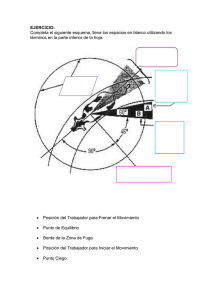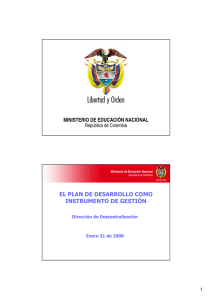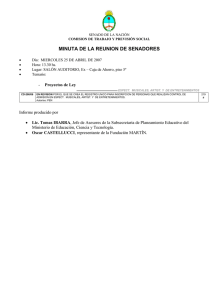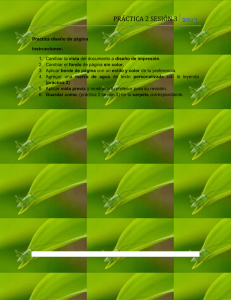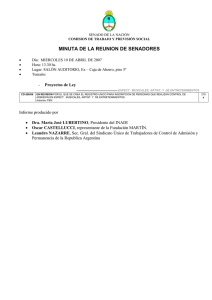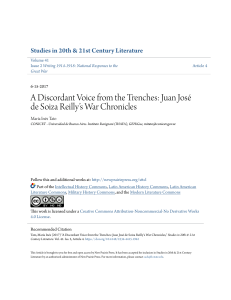ursula wentzlaff - Centro Cultural Recoleta
Anuncio
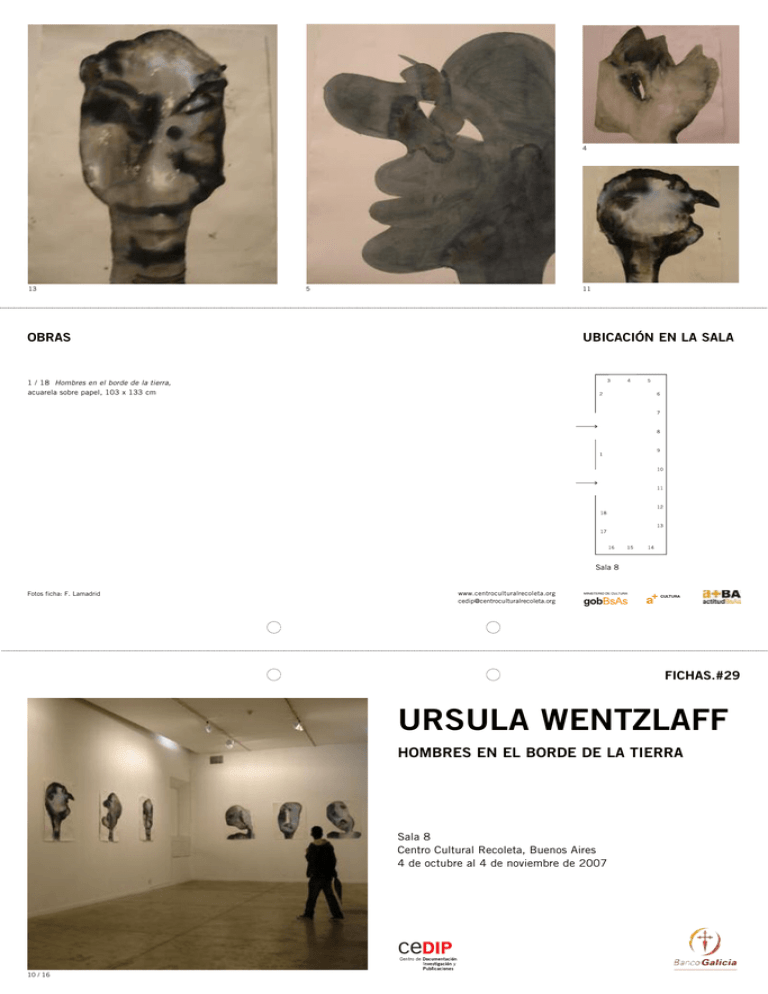
4 13 5 11 OBRAS UBICACIÓN EN LA SALA 1 / 18 Hombres en el borde de la tierra, acuarela sobre papel, 103 x 133 cm Sala 8 Fotos ficha: F. Lamadrid www.centroculturalrecoleta.org [email protected] FICHAS.#29 URSULA WENTZLAFF HOMBRES EN EL BORDE DE LA TIERRA Sala 8 Centro Cultural Recoleta, Buenos Aires 4 de octubre al 4 de noviembre de 2007 10 / 16 PREGUNTAS POTENCIALES Lic. Lara Marmor. Historia del arte, UBA Hombres en el borde de la tierra es una serie de 18 acuarelas que se presentan dentro de la exposición colectiva Berlín Buenos Aires Art Xchange 2007, curada por Dudu Von Thielmann y Holder Volland. Ellas trasladan al espectador a un estado anímico de desolación, que linda entre la perturbación y el desasosiego. Wentzlaff pareciera querer evadir la grandilocuencia del busto romano, representa seres aislados: su rostro, el cuello y excepcionalmente la parte posterior del torso. Pintados sobre una superficie que la artista deja en crudo con el blanco del soporte, la ausencia de recursos espaciales y de datos temporales potencian el dramatismo de su fisonomía, distorsionada, diluida y atravesada por la impronta expresiva de las facciones. Todos se encuentran pintados en una gama mínima de color gris, azul y ocre. Esta paleta rudimentaria vigoriza la sensación de adolescencia que las figuras transmiten. El espectador curioso, puede preguntarse cuáles fueron los motivos que condujeron a Wentzlaff a componer esta serie. Las acuarelas se encuentran cargadas de un subjetivismo antinaturalista, ellas son herederas de la vena expresionista alemana y están alejadas de los ejes que guían la estética contemporánea internacional. Si bien una explicación vinculada al relato autobiográfico no revela las coordenadas para comprender la producción de ningún artista, es sugestivo correr la mirada hacia la historia de esta artista alemana, nacida en 1937 en Heidenheim. Su vida ha atravesado los avatares de la historia de la Alemania de la segunda Guerra Mundial, aquella de la posguerra, la división entre la República Oriental y Democrática, la caída del muro en 1989. El libro Un sí menor y un NO mayor del pintor George Grosz narra su vida en Berlín antes de la Segunda Guerra. El séptimo capítulo, “Descubrimientos del soldado raso Gras”, comienza del siguiente modo: “¿Qué os voy a contar de la Primera Guerra Mundial, en la que tomé parte como soldado de infantería?” Tras retirarse del servicio militar y asentado en su estudio de Berlín, nos cuenta: “Dibujaba hombres borrachos, hombres que vomitaban, hombres que con el puño cerrado maldicen la luna...”. “Dibujaba muchas escenas con soldados, aprovechando las notas que había ido tomando...”. “Dibujé soldados sin nariz, mutilados de guerra con brazos de acero que extendían unas manos como pinzas de cangrejo...”1 Hombres al borde de la tierra transmite un relato inquietante, probablemente nacido de partes entrañables de la artista, de su experiencia. El montaje de la exposición es percibido de forma sintomática; llama la atención la disposición de los trabajos a una altura superior a la habitual para la disposición de obras bidimensionales. Pareciera como si estos rostros estuviesen pendiendo de un pedestal invisible o inexistente. Esta lectura refuerza, una vez más, el distanciamiento del discurso de la obra de la crueldad generada por muchos de los estandartes de la retórica del poder a lo largo de nuestra historia. 1 Grosz, George, Un sí menor y un NO mayor, Madrid, ANAYA & Mario Muchnik, 1991, p. 127. 1 10 16 17 POTENTIAL QUESTIONS Lic. Lara Marmor. Art History, UBA Hombres en el borde de la tierra (Men on the Edge of the Earth) is a series of 18 watercolors that is part of the group show titled Berlín Buenos Aires Art Xchange 2007, curated by Dudu Von Thielmann and Holder Volland. These water colors transport the viewer and create a mood of desolation, on the border between perturbation and uneasiness… Wentzlaff seems to want to evade the grandiloquence of roman busts; she represents isolated beings: their faces, necks and especially the back part of their torsos. They are painted on surfaces that the artist leaves raw, revealing the support’s white tone, and the absence of spatial devices or temporal information increases the dramatic impact of their physiognomy, which is distorted, diluted and permeated by the expressive imprint of each feature. They are painted in a minimal gamma of grays, blues and ochres. This rudimentary palette adds vigor to the sensation of adolescence transmitted by the figures represented. A curious visitor might well ask what motivated Wentzlaff in creating this series. The watercolors are loaded with an anti-naturalistic subjectivity, having inherited aspects of German expressionism, far from the central tendencies that form the parameters of international contemporary aesthetics. Although explanations based on autobiographical narrative do not completely reveal coordinates for comprehending any artist’s production, it is interesting to shift our viewpoint to focus on this German artist’s personal history. Born in Heidenheim in 1937, she has lived through Germany’s history and transformations during and after the Second World War, the division between East and West, the fall of the Berlin wall in 1989… Artist George Grosz narrates his life in Berlin after the Second World War in A Little Yes and a Big No, and chapter seven, “Private Gras’ Discoveries” begins as follows: “What can I tell you about the First World War, in which I formed part of the infantry?” After having left the military service and establishing his studio in Berlin, he relates that “I used to draw men who were drunk, men who were vomiting, men who cursed the moon with clenched fist… “I used to draw soldiers with no nose, men mutilated by the war with steel arms holding out hands like crab’s pincers…” 1 Hombres al borde de la tierra transmits an unsettling tale, probably born out of the artist’s intimate realm and personal experience. The exhibition is mounted in a symptomatic way; the fact that the works are hung at a higher level than usual for two-dimensional works draws the viewer’s attention, it seems as if the faces were hanging from invisible or non-existent pedestals. This reading reinforces yet again the distance between the discourse of this work and the cruelty that has been generated by the insignia of power’s rhetoric throughout our history. Trad.: Tamara Stuby 1 Grosz, George, Un sí menor y un NO mayor, Madrid, ANAYA & Mario Muchnik, 1991, p. 127.
